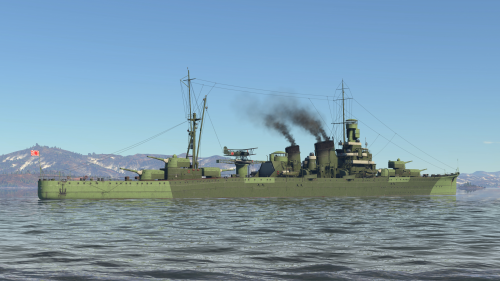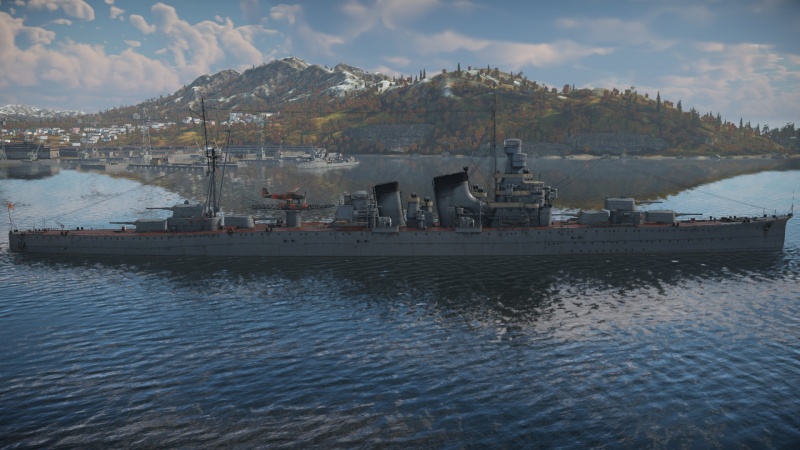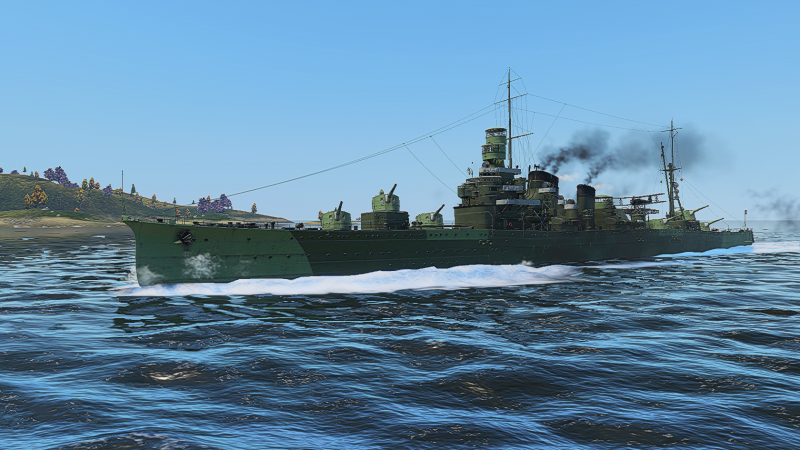IJN Kako
| This page is about the Japanese heavy cruiser IJN Kako. For other Furutaka-class cruisers, see Furutaka (Family). |
Contents
Description
The IJN Kako (加古, namesake: Kako River) was the second ship of the Furutaka-class heavy cruisers of the Imperial Japanese Navy. Much like her sister ship Furutaka, Kako was designed to counter the American Omaha-class light cruisers, featuring high speed and relatively heavy armament for its time to both outrange and outrun them.
After patrolling and engaging in skirmishes around the waters of China in the early 1930s, Kako received a major refit in 1936 to replace her 200 mm guns to the standard 203 mm guns of other Japanese heavy cruisers. She was later assigned to Cruiser Division 6 with her sister Furutaka and a pair of Aoba- class heavy cruisers. Kako and Division 6 would participate in several battles, covering the island-hopping campaign during the early stage of the Pacific war. After the Battle of the Coral Sea, Division 6 would be merged to form the Eighth Fleet. On 8 August 1942, Kako and her fellow Division 6 comrades would engage in the Battle of Savo Island, to which the IJN managed to score a major victory and sunk several Allied ships. Kako was credited for sinking the American heavy cruiser USS Vincennes during the battle. Just two day after the triumph, however, Kako would met her demise on 10 August, when she was ambushed and stuck by three torpedoes from the USS S-44. At that time, she was the largest Japanese warship to be sunk by a submarine.
Introduced in Update 1.89 "Imperial Navy", Kako is in her 1935 configuration (just a year before major refit that replace her turrets similar to her sister ship Furutaka). As with Furutaka, Kako was initially designed to meet the 10,000-ton displacement restrictions of the Washington naval treaty, and as such features several unique quirks for a heavy cruiser. To reduce the weight of the ship, the Kako features only few secondary and AA mounts. While this made her particularly vulnerable against aerial threats, the result is that the Kako has only 8,640 tons of displacement - comparable to most of the post-treaty light cruisers - while having greater protection compared to ships of a similar or higher displacement, as well as similar good mobility. Despite her low BR, Kako should never be underestimated, as her slow-firing 200 mm guns pack quite a punch against most ships she will face, especially at close range.
General info
Survivability and armour
For a heavy cruiser, the Kako's protection is average. The main citadel is covered with 76.2 mm of RHA and citadel deck armour varies between 31.75 to 34.9 mm. The armour can withstand a fair amount of beatings from mid-to-long ranges (6 km or more), thought became much more vulnerable when not angled.
While the Kako features a low crew count of 616 men, she is able to maintain most of her crew due to the lack of secondary and AA mounts, which means she will only lose sailors when the crew compartment is damaged.
Along with her sister ship Furutaka, the Kako has the unique perk of being able to withstand fire damage with little to no crew loss due to her crew compartments is located further away from the deck and are spaced from each other. This ability makes the Kako much more bearable for new captains who don't have FPE, and allows experienced captains to focus on repairing the more serious damage on the ship.
Mobility
Due to her low displacement, the Kako features good mobility that is comparable to a light cruisers. She can accelerate and decelerate faster compared to other heavy cruisers and turns quite well when upgraded.
| Mobility Characteristics | |||
|---|---|---|---|
| Game Mode | Upgrade Status | Maximum Speed (km/h) | |
| Forward | Reverse | ||
| AB | |||
| Upgraded | |||
| RB/SB | |||
| Upgraded | |||
Modifications and economy
Armament
Primary armament
The Kako features six 200 mm 3rd year type No.1 cannons mounted in six single turrets arranged in an unusual A-Bs-C-X-Ys-Z setup. While the turret itself had sluggish traverse speed, this peculiar turret setup allows the A-B and X-Y turrets to rotate freely without having to turn around when the ship is changing directions, as well as provides wide gun coverage when angled.
The 200 mm guns are extremely powerful for the Kako's battle rating, as they can deal a serious damage against more advanced cruisers when aimed properly and are devastating against destroyers that she will usually face. The main guns have access to two type of shells; an HEF shell with 8 kg of TNT equivalent, which is very powerful against destroyers and deals consistent damage against cruisers, and an APC shell with 219 mm of penetration at 10 km with decent 3 kg of explosive filler, this shell is able to penetrate any opponent and deal serious internal damage, as well as penetrate dreadnoughts at close range.
On the other hand, the 200 mm guns have a slow reload time of 15 seconds (ace crew), and a whooping 22 seconds when all the ammunition in the ready rack has been used. The guns also have a rather poor accuracy as the shells will occasionally scatter around the target.
| Penetration statistics | |||||||
|---|---|---|---|---|---|---|---|
| Ammunition | Type of warhead |
Penetration @ 0° Angle of Attack (mm) | |||||
| 1,000 m | 2,500 m | 5,000 m | 7,500 m | 10,000 m | 15,000 m | ||
| HE common | HE | 60 | 60 | 60 | 60 | 60 | 60 |
| Type 88 APCBC | APCBC | 352 | 311 | 253 | 208 | 173 | 129 |
| Shell details | ||||||||||||
|---|---|---|---|---|---|---|---|---|---|---|---|---|
| Ammunition | Type of warhead |
Velocity (m/s) |
Projectile mass (kg) |
Fuse delay (s) |
Fuse sensitivity (mm) |
Explosive mass (TNT equivalent) (kg) |
Ricochet | |||||
| 0% | 50% | 100% | ||||||||||
| HE common | HE | 870 | 110 | 0 | 0.1 | 8.03 | 79° | 80° | 81° | |||
| Type 88 APCBC | APCBC | 870 | 110 | 0.03 | 9 | 3.12 | 48° | 63° | 71° | |||
Secondary armament
The secondary armament of the Kako is four 120 mm 10th year type cannons, placed in pairs on the port and starboard side of the superstructure. The guns have a short reload time of 4 seconds and a relatively good accuracy. This, however, is your only line of defense against aircraft, as your anti-air armament is just four machine guns. The guns are loaded with HEF shells by default with an option to use HE-TF shell for anti-air defence.
| Penetration statistics | |||||||
|---|---|---|---|---|---|---|---|
| Ammunition | Type of warhead |
Penetration @ 0° Angle of Attack (mm) | |||||
| 1,000 m | 2,500 m | 5,000 m | 7,500 m | 10,000 m | 15,000 m | ||
| 120 mm Type 1 HE | HE | 24 | 24 | 24 | 24 | 24 | 24 |
| 120 mm Type 0 HE | HE-TF | 24 | 24 | 24 | 24 | 24 | 24 |
| Shell details | ||||||||||||
|---|---|---|---|---|---|---|---|---|---|---|---|---|
| Ammunition | Type of warhead |
Velocity (m/s) |
Projectile mass (kg) |
Fuse delay (s) |
Fuse sensitivity (mm) |
Explosive mass (TNT equivalent) (kg) |
Ricochet | |||||
| 0% | 50% | 100% | ||||||||||
| 120 mm Type 1 HE | HE | 850 | 20.33 | 0 | 0.1 | 1.95 | 79° | 80° | 81° | |||
| 120 mm Type 0 HE | HE-TF | 850 | 20.33 | 0 | 0.1 | 1.95 | 79° | 80° | 81° | |||
Anti-aircraft armament
The Kako has only four 13.2 mm Type 93 machine guns for anti-air armament. The guns are mounted in a twin-barrelled setup on the ship's superstructure. The guns have very poor damage output and will not help to deter any aircraft and PT boats that come close to the Kako. This leaves the 120 mm guns as the only reliable defensive weapons against PT boats.
Additional armament
The Kako is loaded with 24 x 610 mm Type 8 No.2 torpedoes, launched from fixed launchers on each side of the ship. From each side can be launched up to 12 torpedoes, with six loaded inside the tube and other six in the ready racks. While the torpedoes are not as fast or powerful as the famous Type 93 torpedoes, they still pack 380.6 kg of TNT equivalent, which can sink a destroyer in a single hit and deal a considerable amount of damage against cruisers. Unfortunately, the aforementioned fixed torpedo launchers will limit the usage of the torpedoes, as you will have to move your hull to adjust your torpedo aim and exposing your vulnerable sides. Thus it is mostly suitable for mid-to-long range area denial barrages.
Scout plane
Located amidships is a catapult with one E7K2 scout plane which provides unique offensive and defensive abilities, expanding tactical options. Ship-launched scout planes fly just like regular tree units but lack munition choices and cockpit views. The E7K2 is equipped with only defensive machine gun turrets (ventral as well as dorsal) but it does carry 4 x 60 kg bombs. It also has the scout plane ability to cap zones and lay down smoke cover (up to 3 times). Captains will be wise to remember to utilize the aircraft and consider when best to use it, for example to cap a point early or late in the match, to create a smoke screen to stymie enemy bombardment and repair, to attack enemy units directly, or perhaps something completely new! Carrying a heavier bomb load than most other scout planes, this unit has a very good chance to sink enemy boats or even a destroyer.
Usage in battles
The Kako's playstyle mostly depends on the opponent she faces. In a match with the same tier opponents such as destroyers and early light cruisers, the Kako is capable of pushing the targets by lending its devastating firepower at its battle rating to quickly dispatch the opponents while tanking hits in return. Otherwise when facing more advanced and better-protected cruisers, the Kako can act as a fire support ship, delivering powerful salvo and launching barrages of torpedoes at longer ranges. Her main anti-air armament are the 120 mm secondaries, especially when equipped in HE-TF shells, while they will rarely stop a dive bomber, they can score kills against a larger bombers at range, like a Pe-8. For that reason, it's best to stay near friendly (preferably non-Japanese) warships that can provide a more potent anti-air cover.
Pros and cons
Pros:
- Great main armament
- 6 powerful 200 mm (7.9 inch) cannons
- Guns have separate turrets which allows to keep more firepower active as a turret gets taken out
- Shells are falling in a relatively parallel line, making it easier to score multiple hits against targets in a medium-to-long range
- Good top speed and agility
- Good survivability
- Very durable against destroyers
- Can bounce several shots when angled properly
- Resilient against fire damage
- Carries large amount of torpedoes
- Carries a scout plane
Cons:
- Fixed torpedo launchers
- Easily blows up if the ammo rack gets hit (poorly protected)
- Weak anti-air capability
- Poorly protected turrets can be easily knocked out
- Slow turret traverse
- Large target and usually priority targeted over other vessels especially by airplanes carrying large payloads
History
Created as a counter to the American Omaha and British Hawkins class cruisers, the Furutaka class was designed to act as a scouting cruiser capable of protecting the main fleet from enemy scouts. While the ship was designed before the Washington Naval Treaty, she still fell within the displacement and calibre limits with 7,500 tons of displacement and the main armament of six 7.9 in/20 cm cannons mounted in single turrets; she also had a torpedo armament of 12 x 21-inch torpedo tubes mounted in the hull. These armaments would change as both Furutaka and Kako were modernized shortly after being completed, with their single mounted guns being replaced with three twin turrets and two quad-torpedo launchers being added near the aft.
During the first months of the Pacific War against the United States, Kako was assigned to Sentai 6 and tasked in covering the invasions of several islands including Guam, Wake, and New Guinea. Sentai 6 was then assigned to Operation MO, the invasion of Port Morseby, and partook in the Battle of the Coral Sea on May 7, 1942. Their next major action would not be until August, but would also be their largest. Kako and Sentai 6 had been assigned to the new Eighth Fleet. In response to the American invasion of Guadalcanal, the Eighth Fleet sortied out to counter the invasion force. On the night of August 8-9, 1942, Kako and the fleet of 4 heavy cruisers, 2 light cruisers, and a destroyer surprised the Allied Fleet in a night attack off Savo Island.
Fighting at close ranges with searchlights, flares, and star shells, Japanese naval artillery devastated the Allied fleet, sinking 4 heavy cruisers and forcing the American support ships to abandon the Marines on the island. While the battle was a stunning victory for the Japanese, they failed to sink any of the landing ships and fled the area for fear of retaliation from American carrier planes; However, it was the American submarine S-44 who got revenge. On August 10, while the Eighth fleet was returning to Rabaul, the S-44 fired four torpedoes at Kako, scoring three hits. The Kako quickly took on a list before her boilers detonated, sinking the cruiser but only taking 68 sailors with her. Kako was struck from the Japanese Naval list a month later.
Media
- Skins

See also
Links to articles on the War Thunder Wiki that you think will be useful for the reader, for example:
- reference to the series of the ship;
- links to approximate analogues of other nations and research trees.
External links
- Japanese cruiser Kako - Wikipedia
- [World War II Database] Kako Photographs
- [Lou Coatney's Military and Naval Historical Chess Games/Brettspiller, Writings, and Models] Kako class Heavy Cruisers
| Kawasaki Shipyard Co. (川崎造船) | |
|---|---|
| Destroyer Escorts (DE) | |
| Ikazuchi-class | Ikazuchi |
| Heavy Cruisers (CA) | |
| Furutaka-class | IJN Kako |
| Battleships (BB) | |
| Kongō-class | IJN Haruna* |
| Ise-class | IJN Ise |
| Notes | *Initially laid down as battlecruiser, later modified and reclassified as (Fast) Battleship (FBB). |
| See also | Kawasaki Aircraft Industries |
| Japan heavy cruisers | |
|---|---|
| Furutaka-class | IJN Furutaka · IJN Kako |
| Aoba-class | IJN Aoba |
| Myōkō-class | IJN Myoko · IJN Haguro |
| Mogami-class | IJN Mogami |
| Tone-class | IJN Tone |







